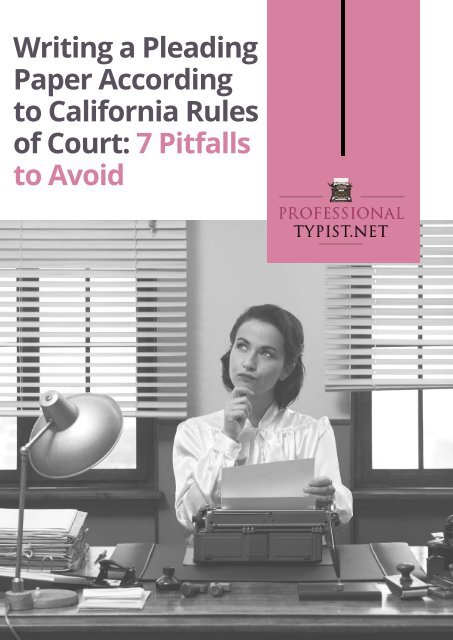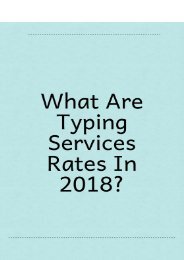California Rules of Court Pleading Format
Howdy! Take a look at this article and discover california rules of court pleading format. To find more details visit site http://www.professionaltypist.net/california-rules-of-court-pleading-format/
Howdy! Take a look at this article and discover california rules of court pleading format. To find more details visit site http://www.professionaltypist.net/california-rules-of-court-pleading-format/
Create successful ePaper yourself
Turn your PDF publications into a flip-book with our unique Google optimized e-Paper software.
Writing a <strong>Pleading</strong><br />
Paper According<br />
to <strong>California</strong> <strong>Rules</strong><br />
<strong>of</strong> <strong>Court</strong>: 7 Pitfalls<br />
to Avoid
If you want to make a plea in court,<br />
you need to submit the correct<br />
documents while following some<br />
very precise rules and regulations.<br />
The last thing you want is to have<br />
your documents rejected just<br />
because you came across one <strong>of</strong><br />
the many avoidable pitfalls present<br />
within the rules <strong>of</strong> court in<br />
<strong>California</strong>. Take a look at the most<br />
commonly made mistakes when<br />
writing a pleading paper, and you’ll<br />
be sure to submit or defend<br />
against a plea with ease.<br />
C o m m o n M i s t a k e s W h e n W r i t i n g a<br />
P l e a d i n g P a p e r<br />
Some <strong>of</strong> the most frequently occurring mistakes happen due to<br />
sloppiness or inattentiveness on the part <strong>of</strong> the person writing the<br />
document in question, whereas other errors result when people<br />
simply don’t know the rules that apply when writing a pleading<br />
paper or any other legal document to be submitted in the State <strong>of</strong><br />
<strong>California</strong>. Check out the pitfalls below and make sure you steer<br />
clear <strong>of</strong> every last one <strong>of</strong> them.
1<br />
2<br />
The first thing to consider is the paper you want to use. Much<br />
like it’s <strong>of</strong>ten said in the case <strong>of</strong> writing a resume or CV, you<br />
really need to follow the prescribed rules even down to how<br />
you use paper. In fact, it’s strictly enforced that your paper<br />
should be printed on one side, each leaf measuring 8.5” x 11”<br />
and having a density <strong>of</strong> at least 20 pounds. Ultimately, this<br />
benefits your case as you can get your point across concisely,<br />
quickly and pr<strong>of</strong>essionally.<br />
Just like when you’re applying for a new driving license or<br />
any other <strong>of</strong>ficial document, you’ll find that a pleading<br />
paper will only be accepted by the court if you use a dark<br />
color <strong>of</strong> ink such as black or blue-black. This may seem a<br />
silly recommendation, but it’s actually one <strong>of</strong> the easiest<br />
pitfalls to become victim to. The reason for this regulation<br />
is because lighter inks may be harder to read, and this<br />
effect is only exacerbated after photocopying.
3<br />
Even the layout <strong>of</strong> your document down to the spacing and<br />
margins should be completed according to very specific<br />
guidelines. This kind <strong>of</strong> systematic formatting may not seem<br />
important, and it’s all too easy to actively ignore it, but there’s<br />
a very good reason for such restrictions to be in place. When<br />
legal pr<strong>of</strong>essionals see documents in a layout they are familiar<br />
with, it enables them to quickly get to the bottom <strong>of</strong> the case<br />
at hand. If you make their lives easier, then it can only benefit<br />
you. Your margins should be at least 1” on the left and 0.5” on<br />
the right.<br />
4<br />
Just like when you’re<br />
applying for a new driving<br />
license or any other<br />
<strong>of</strong>ficial document, you’ll<br />
find that a pleading paper<br />
will only be accepted by<br />
the court if you use a dark color <strong>of</strong><br />
ink such as black or blue-black.<br />
This may seem a silly<br />
recommendation, but it’s actually<br />
one <strong>of</strong> the easiest pitfalls to<br />
become victim to. The reason for<br />
this regulation is because lighter<br />
inks may be harder to read, and<br />
this effect is only exacerbated<br />
after photocopying.
5<br />
Font usage is another consideration that is <strong>of</strong>ten ignored by<br />
those who are new to submitting legal documents to courts in<br />
<strong>California</strong>. Make sure that you use a standard pr<strong>of</strong>essional font<br />
like Times New Roman or Arial, and always choose a size 12 or<br />
larger. Another point to remember is that you should include a<br />
footer at the bottom <strong>of</strong> your document, which should repeat<br />
the title <strong>of</strong> your pleading paper in font size 10.<br />
6If you don’t have much experience with legal affairs, then<br />
you probably aren’t aware that the first page <strong>of</strong> any<br />
submitted document needs to include a range <strong>of</strong> different<br />
clauses that are applicable to your case. Many novice<br />
plaintiffs forget about this, so make sure that you don’t. If<br />
you’re unsure, a pr<strong>of</strong>essional template will help.<br />
Numbering your pages is vital if you’re going to<br />
present a coherent argument that any reader can<br />
follow with ease, but it’s common to find documents<br />
without such formatting. To avoid having your paper<br />
thrown out <strong>of</strong> court, always add page numbers<br />
according to the rules stipulated.<br />
7
8<br />
Plenty <strong>of</strong> people try to write their own pleading paper without<br />
seeking any kind <strong>of</strong> pr<strong>of</strong>essional assistance. This is a big<br />
mistake, because you really want someone on your side who<br />
has seen and done it all before. Getting a pr<strong>of</strong>essional advisor<br />
to help you write your paper is the wisest thing you can do.<br />
S i m p l e S t e p s t o L e g a l<br />
S u c c e s s<br />
Whether you’re submitting a plea or<br />
defending against one in a <strong>California</strong><br />
court <strong>of</strong> law, you’ve got to know exactly<br />
what you’re doing. Your newfound<br />
knowledge starts with discovering how<br />
to format your documents in the right<br />
way so that they are accepted by the<br />
court. Avoid the 7 most frequently<br />
encountered pitfalls outlined here in<br />
this handy guide, and your legal aims<br />
will surely hit the target.<br />
Knowledge is power when it comes to the law. Learn<br />
everything you can about <strong>California</strong> rules <strong>of</strong> court<br />
pleading format.






